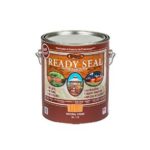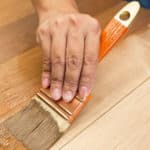A cedar fence is a beautiful addition to any home, but it can quickly turn gray if not properly maintained. This article will discuss how to prevent your cedar fence from turning gray and how to clean and maintain it once it has turned gray.
Why Cedar Turns Gray?
Cedar is a beautiful wood used for fences, decks, and siding. However, cedar is susceptible to turning gray over time.
There are several reasons why this happens:
- Ultraviolet rays from the sun can damage the wood and cause it to turn gray
- Dirt and debris can build up on the surface of the wood, causing it to turn gray
- Water can cause the wood to swell and crack, which can also lead to it turning gray
How to Prevent Cedar From Turning Gray?
There are several things you can do to prevent your cedar fence from turning gray:
- Clean the fence regularly with a mild soap and water solution
- Apply a stain or sealer to the fence to protect it from the sun and weather
- Repair any cracks or damage to the fence as soon as possible
- Keep the fence free of dirt and debris
How to Clean a Gray Cedar Fence?
If your cedar fence has already turned gray, don’t despair! It can still be cleaned and restored to its original beauty.
Here are a few tips on how to clean a gray cedar fence:
- Use a power washer to remove dirt, debris, and grime from the fence
- Scrub the fence with a stiff brush and soapy water to remove any stubborn stains
- Apply a stain or sealer to the fence to protect it from the sun and weather
- Repair any cracks or damage to the fence as soon as possible
What Can I Put On My Cedar To Keep The Color?
Staining or sealing your cedar fence is the best way to keep it looking its best.
Many types of stains and sealers are available, so be sure to choose one that is right for your specific needs.
You can also talk to a professional about which type of stain or sealer would be best for your fence.
How Do You Keep Cedar Looking Natural?
You can use a clear sealer or stain if you want to keep your cedar fence looking natural.
This will allow the wood grain to show through while still protecting the wood from the sun and weather.
You can also leave your fence untreated, but it will require more maintenance and may turn gray more quicker.
How Often Should I Clean My Cedar Fence?
You should clean your cedar fence at least once a year, but more often if it is in a high-traffic area or exposed to the elements.
Cleaning your fence regularly will help prevent it from turning gray and keep it looking its best.
Should I Clear Coat My Cedar Fence?
Use as few chemicals and sprinklers on your cedar fence as possible. Although cedar is naturally water-resistant, it is not waterproof. Chemicals and water exposure can reduce the lifespan of cedar. You should never apply Clear Water Sealer or anything clear to Cedar.
Can You Leave Cedar Untreated?
Cedar shakes, which are individual planks of one of several cedar forms, will discolor and soften over time unless adequately treated. Depending on the climate, cedar siding may rot after about five years if left untreated.
There are some ways to cover cedar siding, for example, stain, a solid-color coating, or whitewash.
Are Cedar Fences Worth It?
When it comes to fences, cedar is widely considered to be one of the best materials you can use. It’s naturally insect and rot-resistant, which means it will last longer than other types of wood. It’s also stable, so it won’t shrink, splinter, or warp over time. And because it’s naturally light in color, it won’t require frequent staining or painting.
In short, a cedar fence is a wise investment that will provide years of beauty and utility. Cedar is the way to go if you’re looking for a fence that will stand the test of time.
Does Cedar Fence Last Longer Than Pressure-Treated Wood?
Pressure-treated wood is less durable and more prone to decay than cedar. If left untreated, pressure-treated timber can bend and rot after a few years, but cedar has greater natural durability.
Is Cedar The Best Wood For A Fence?
Cedar fence is a wonderful material for fencing since it contains natural oils that are harmful to insects. Cedar wood is a reasonable option that may be more suited to a tight budget and is also rot-resistant, allowing it to last longer than other woods.
Which Is Better For Fencing Redwood Or Cedar?
If you’re looking for a fencing material that is strong and durable, you can’t go wrong with redwood. Strength is important in a fencing material because it needs to be able to withstand the elements and possible damage from things like falling branches. Redwood is also a naturally rot-resistant wood, so that it will last longer than other options like cedar.
Regarding pricing, redwood is typically more expensive than cedar, but it’s worth the investment because you’ll get a higher quality product that will last longer. Overall, redwood is the better choice for fencing, especially if you’re looking for something that will stand the test of time.
Does A Cedar Fence Need To Be Sealed?
Every three to five years, apply a sealer to your cedar fence. Allow no more water to come into contact with the fence than is necessary. It’s difficult to keep rainwater off the fence.
Even after applying a sealer, do not install sprinklers where the water current strikes the fence.
How Do I Keep My Cedar Fence Looking New?
To prevent the cedar fence from splintering, cracking, and warping due to the elements, apply a waterproofer after sanding it. Using a paintbrush, apply two thin coats of waterproofer. Allow time for each layer of sealer to dry before applying the next coat.
Every three to five years, your cedar fence should be sanded and resealed to keep it looking new.
What Are The Disadvantages Of Cedar Wood?
Cedarwood has many disadvantages that should be considered before using it for any construction project. These disadvantages include the need for regular maintenance, the fact that it is flammable, and its sensitivity to changes in temperature and moisture levels.
Cedar is also not as strong as some other woods, making it more likely to break or warp. Despite these disadvantages, cedar is still a popular choice for many construction projects due to its affordability.
When deciding whether or not to use cedar wood for your next project, carefully weigh all the pros and cons. With a little bit of planning and effort, you can still use cedar wood in a way that minimizes its disadvantages.
Conclusion
We hope you found this article helpful! If you have any questions, please feel free to contact us.
Thanks for reading!



